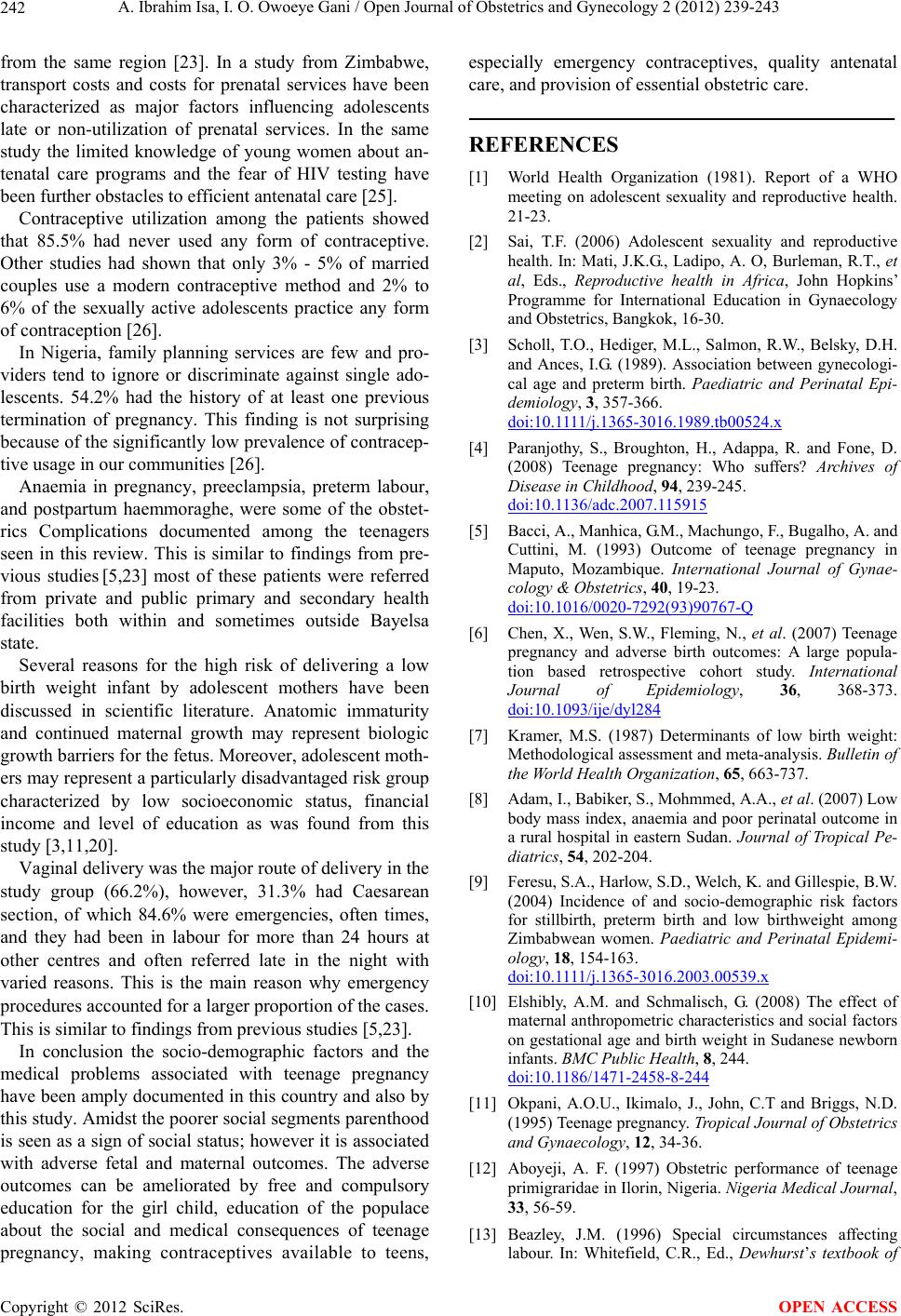
A. Ibrahim Isa, I. O. Owoeye Gani / Open Journal of Obstetrics and Gynecology 2 (2012) 239-243
242
from the same region [23]. In a study from Zimbabwe,
transport costs and costs for prenatal services have been
characterized as major factors influencing adolescents
late or non-utilization of prenatal services. In the same
study the limited knowledge of young women about an-
tenatal care programs and the fear of HIV testing have
been further obstacles to efficient antenatal care [25].
Contraceptive utilization among the patients showed
that 85.5% had never used any form of contraceptive.
Other studies had shown that only 3% - 5% of married
couples use a modern contraceptive method and 2% to
6% of the sexually active adolescents practice any form
of contraception [26].
In Nigeria, family planning services are few and pro-
viders tend to ignore or discriminate against single ado-
lescents. 54.2% had the history of at least one previous
termination of pregnancy. This finding is not surprising
because of the significantly low prevalence of contracep-
tive usage in our communities [26].
Anaemia in pregnancy, preeclampsia, preterm labour,
and postpartum haemmoraghe, were some of the obstet-
rics Complications documented among the teenagers
seen in this review. This is similar to findings from pre-
vious studies [5,23] most of these patients were referred
from private and public primary and secondary health
facilities both within and sometimes outside Bayelsa
state.
Several reasons for the high risk of delivering a low
birth weight infant by adolescent mothers have been
discussed in scientific literature. Anatomic immaturity
and continued maternal growth may represent biologic
growth barriers for the fetus. Moreover, adolescent moth-
ers may represent a particularly d isadvantaged risk group
characterized by low socioeconomic status, financial
income and level of education as was found from this
study [3,11, 2 0] .
Vaginal delivery was the major route of delivery in the
study group (66.2%), however, 31.3% had Caesarean
section, of which 84.6% were emergencies, often times,
and they had been in labour for more than 24 hours at
other centres and often referred late in the night with
varied reasons. This is the main reason why emergency
procedures accounted for a larger proportion of the cases.
This is similar to findings from previous studies [5,23].
In conclusion the socio-demographic factors and the
medical problems associated with teenage pregnancy
have been amply documented in this country and also by
this study. Amidst the poor er social segments parenthood
is seen as a sign of social status; however it is associated
with adverse fetal and maternal outcomes. The adverse
outcomes can be ameliorated by free and compulsory
education for the girl child, education of the populace
about the social and medical consequences of teenage
pregnancy, making contraceptives available to teens,
especially emergency contraceptives, quality antenatal
care, and provision of essential obstetric care.
REFERENCES
[1] World Health Organization (1981). Report of a WHO
meeting on adolescent sexuality and reproductive health.
21-23.
[2] Sai, T.F. (2006) Adolescent sexuality and reproductive
health. In: Mati, J. K.G., Ladipo, A. O, Burlema n, R.T., et
al, Eds., Reproductive health in Africa, John Hopkins’
Programme for International Education in Gynaecology
and Obstetrics, Bangkok, 16-30.
[3] Scholl, T.O., Hediger, M.L., Salmon, R.W., Belsky, D.H.
and Ances, I.G. (1989). Association between gynecologi-
cal age and preterm birth. Paediatric and Perinatal Epi-
demiology, 3, 357-366.
doi:10.1111/j.1 36 5-3016.1989.tb00524.x
[4] Paranjothy, S., Broughton, H., Adappa, R. and Fone, D.
(2008) Teenage pregnancy: Who suffers? Archives of
Disease in Childhood, 94, 239-245.
doi:10.1136/adc.2007.115915
[5] Bacci, A., Manhica, G.M., Machungo, F., Bugalho, A. and
Cuttini, M. (1993) Outcome of teenage pregnancy in
Maputo, Mozambique. International Journal of Gynae-
cology & Obstetrics, 40, 19-23.
doi:10.1016/0020-7292(93)90767-Q
[6] Chen, X., Wen, S.W., Fleming, N., et al. (2007) Teenage
pregnancy and adverse birth outcomes: A large popula-
tion based retrospective cohort study. International
Journal of Epidemiology, 36, 368-373.
doi:10.1093/ije/dyl284
[7] Kramer, M.S. (1987) Determinants of low birth weight:
Methodological assessment and meta-analysis. Bulletin of
the World Health Organization, 65, 663-737.
[8] Adam, I., Babike r, S., Mohmmed, A.A., et al. (2007) Low
body mass index, anaemia and poor perinatal outcome in
a rural hospital in eastern Sudan. Journal of Tropical Pe-
diatrics, 54, 202-204.
[9] Feresu, S.A., Harlow, S.D., Welch, K. and Gillespie, B.W.
(2004) Incidence of and socio-demographic risk factors
for stillbirth, preterm birth and low birthweight among
Zimbabwean women. Paediatric and Perinatal Epidemi-
ology, 18, 154-163.
doi:10.1111/j.1 36 5-3016.2003.00539.x
[10] Elshibly, A.M. and Schmalisch, G. (2008) The effect of
maternal anthropometric characteristics and social factors
on gestational age and birth weight in Sudanese newborn
infants. BMC Public Health, 8, 244.
doi:10.1186/1471-2458-8-244
[11] Okpani, A.O.U., Ikimalo, J., John, C.T and Briggs, N.D.
(1995) Teenage pregnancy. Tropical Journal of Obstetrics
and Gynaecology, 12, 34-36.
[12] Aboyeji, A. F. (1997) Obstetric performance of teenage
primigraridae in Ilorin, Nigeria. Nigeria Medical Journal,
33, 56-59.
[13] Beazley, J.M. (1996) Special circumstances affecting
labour. In: Whitefield, C.R., Ed., Dewhurst’s textbook of
Copyright © 2012 SciRes. OPEN ACCESS